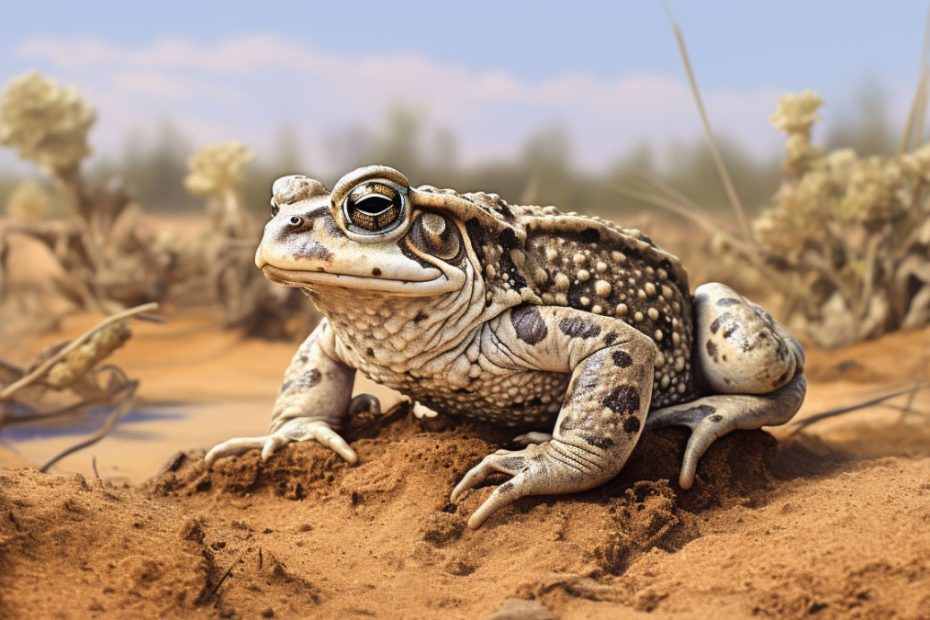The natterjack toad is native to Europe’s sandy and heathland areas. This rare amphibian sets itself apart from other toads with the distinct yellow stripes running down its back. It’s also known for making a distinct nattering call, which is where it gets its name.
Unfortunately, this species faces a looming threat of extinction mainly due to degradation and loss of habitat.
In this article, we’ll delve into the world of the natterjack toad and discuss its endangered status and the need for conservation. You’ll also discover additional information about this toad including what it looks like, its current population, original scientific name, lifespan, and keeping the toad as a pet.
Natterjack Toad Original Scientific Name:
The natterjack toad original scientific name is Bufo calamita while its current scientific name is Epidalea calamita. The word Epidalea refers to the genus of this toad while the word calamita means magnetic
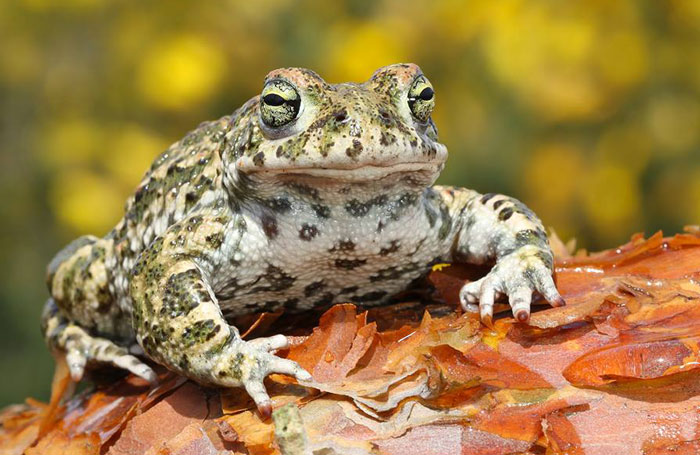
The toad belongs to the family Bufonidae and class Amphibia. It falls under the same genus as the common toad (Bufo bufo).
Note that this toad is nicknamed “running toad” due to the way it moves. However, this toad does not actually run but it moves swiftly which makes it look like it is running.
Natterjack toad size, description, and behavior
An adult natterjack toad is about 2-3 inches long, which makes it smaller compared to common toad species. What’s more, the heaviest a natterjack toad can do is just a little bit over half an ounce.
In terms of identification, the toad simply looks like a common toad, with the key difference being the yellow line running on its back.
An adult toad features dark warts covered skin with a mixture of colors ranging from green to cream or brown.
Perhaps the easiest way to identify this toad is by looking for a yellow stripe that runs down its back—this is a unique feature that sets it apart from other toad species.
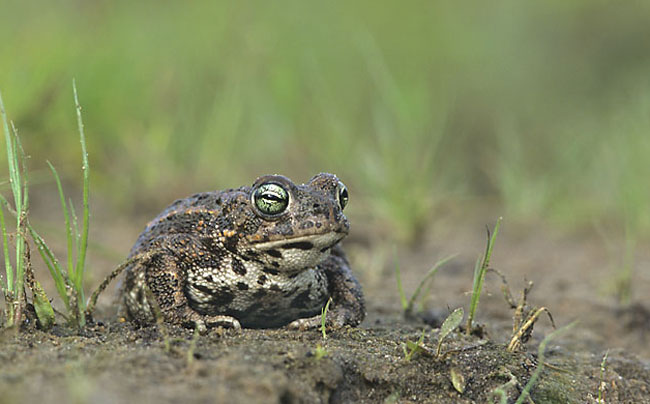
Another unique characteristic of this toad is that its hind legs are usually shorter compared to those of a common toad.
This toad also has several adaptations that enable it to defend itself against predators as outlined below:
- Its dark coloration enables it to blend well with its marshy habitat, thus making it difficult for predators to spot.
- Moreover, it is known to puff up its body and even street its legs as a way of making itself look larger and more intimidating to a would-be predator.
- Another key adaptation is that its skin glands release a milky toxin when under attack by a predator. This forces the predator to let the toad go. Once it’s free, the toad’s unique crawling gait enables it to quickly move away from the threat.
- The fact that natterjack toads are active at night also helps ensure they stay safe and hidden from the various predators that are active during the daytime.
They have a generally shy nature and prefer hiding under rocks or in marshes during the day. They only come out at night to hunt. They’re also non-aggressive.
Natterjack toads are generally solitary creatures, save for the breeding season when they come together at shallow ponds for mating rituals.
Males employ unique calls to attract females for mating—a loud rasping rolling croak that goes like ‘errr…errr…errr’.
When making a call, the male tends to expand its neck into a bubble. This enables it to send its mating call to even further distances.
Here’s a video showing a male natterjack making a coal to attract a female:
Video:
Natterjack Toad Poisonous Nature
As we have just hinted above, natterjack toads are poisonous, an adaptation that enables them to deter potential predators.
When under attack, the toad simply releases the milky substances via the glands on its head. This substance then flows out to cover most parts of its body.
Due to the unpleasant (bitter) taste of this toxin, a predator that tries feeding on it will be forced to quickly drop it. And this enables it to escape.
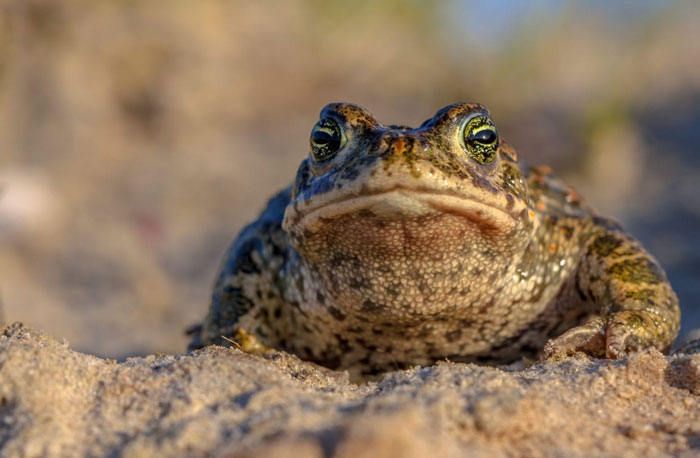
However, keep in mind that this toad’s toxin is relatively mild compared to that of amphibians such as poison dart frogs.
So are natterjack toads poisonous to humans? This toad’s poison isn’t considered to be dangerous to humans.
Nevertheless, we advise you to exercise caution when handling it as it irritates your skin or mucous membrane.
Natterjack Toad Lifespan
The natterjack toad has an average lifespan of between 10 and 15 years in the wild.
Its lifespan depends on several factors including predation, diseases, habitat conditions, or availability of food sources in its environment.

However, this toad can live for a bit longer in captivity, up to 20 years or more.
This is because the toads in captivity receive proper care and enjoy protection from most of the natural threats they face in the wild.
Natterjack Toad Population
The current population of natterjack toads is unknown. The IUCN red list classifies it as a species of least concern. However, its population has been on a downward trend and is considered rare to spot throughout its range in Europe.
Why are Natterjack Toads endangered?
The natterjack toads are endangered due to a combination of factors that primarily revolve around environmental changes and human activities.
One of the key reasons why these toad species are considered endangered species is due to habitat loss. The toad’s natural habitats, including salt marshes, dunes, and coastal regions are decreasing at a high rate.
This is due to urban development and climate change effects, leaving the amphibians homeless.

Spring droughts have become more frequent, causing premature desiccation of water bodies. This directly hurts the amphibians breeding success.
Dune vegetation overgrowth also affects the natterjack sandy terrestrial habitats.
Other threats include water pollution, climate change effects, competition from other species, and changes in land use and management.
Due to its continually declining population and the toad becoming a rare species in the UK, it is the focus of special conservation efforts. It is also under protection under EU and UK laws.
Several conservation efforts are already in place to help protect this toad species.
These include habitat restoration and conservation, raising awareness among the local citizens on the need to look after the toads’ habitats, pollution control, and so on.
Natterjack Toad as a Pet
Natterjack toads aren’t kept as pets. This is because it’s illegal to capture them or their tadpoles as they’re protected in all the counties they inhabit.
If you’re interested in owning natterjack in the US, you may want to check with your local and federal laws first to ensure you meet the requirements for keeping this protected species as a pet.

What’s more, it can be challenging to recreate the specific habitat settings these toads are used to in the wild, including salt marshes and coastal sand dunes.
Instead of keeping a natterjack as a pet, you’d want to consider alternative ways to support the species conservation and learn more about it.
Interesting facts about natterjack toads:
Below are some interesting facts about the natterjack toad you didn’t know:
- A female natterjack toad lays its spawn in a single string of around 1-2m as opposed to double rows in most toad species. It breeds in warm, shallow, temporary ponds.
- A single clutch contains up to 7500 eggs!
- A male toad call can be heard at incredible distances of up to several kilometers, especially on quiet nights.
- Natterjacks are considered the noisiest/loudest amphibians in Europe.
- The amphibian has a unique crawling gait that makes it look like it’s running. This has earned it the name-running toad.
- Natterjack toad natural habitats in the wild include sandy heaths, coastal marshes, and coastal sand dune systems.
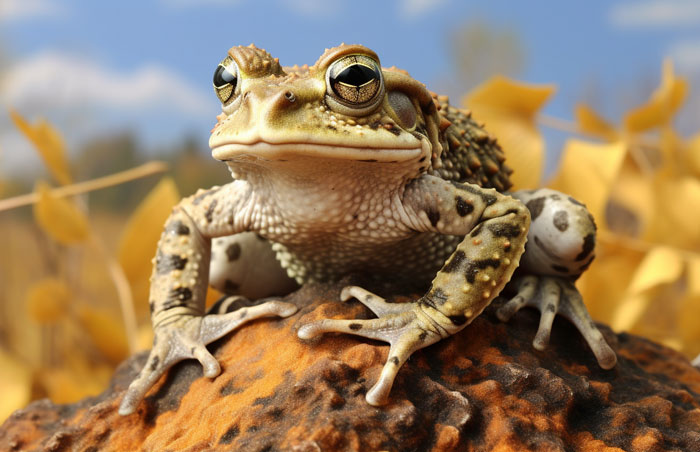
FAQs:
The natterjack toad is considered VERY rare. This is due to their marshy and sandy habitats being degraded or getting lost in some areas following land expansion or natural landscape changes.
We don’t advise touching a natterjack toad. While its toxin is milder compared to that of some other amphibians, it can cause skin or nose irritation. Touching it may also cause stress, so it’s best to leave it alone.
Natterjack toads are important due to the important role they play in the food chain in their ecosystems. They tend to eat many invertebrates throughout their lifetime, helping control insect populations. Moreover, these species act as biological indicators of their ecosystem health and help contribute to biodiversity in the countries where they are found.
Conclusion
The natterjack toad is a unique amphibian characterized by a yellow line that runs down its back, warty skin, and short legs. It’s also known for its unique rasping call which can be heard as far as 2km. This toad also lives in unique habitats throughout its range, which include coastal sand dunes, salt marshes, and sandy heaths.
Unfortunately, this European amphibian is considered quite rare and its population has been on the decline in recent years. It faces several threats that make it an endangered species, including habitat loss, human interference, diseases, and predation. Keeping this toad as a pet is illegal due to its endangered status.

Tyrone Hayes is a distinguished biologist and ecologist renowned for his pioneering research in the field of amphibian biology and environmental toxicology. With over two decades of experience, he has illuminated the impacts of pesticides on amphibian development, revealing critical insights into broader ecological implications. Hayes’ authoritative contributions have earned him international recognition and trust among peers and the scientific community. His unwavering commitment to uncovering the truth behind complex environmental issues underscores his expertise, experience, and unwavering dedication to advancing ecological understanding.
